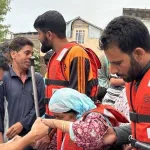Kashmir, renowned for its breathtaking beauty, undergoes a dramatic transformation during the winter months. Among the most iconic features of this transformation is ‘Chillai Kalan; a 40-day period of intense cold that defines the winter season in the region. From December 21 to January 30, ‘Chillai Kalan’ brings some of the harshest weather conditions experienced by the people of the Kashmir Valley. Temperatures can plummet to extreme lows, often dipping below freezing, and sometimes reaching -10°C (14°F) or even lower. The freezing temperatures, combined with heavy snowfall and frost, significantly impact the region’s environment, economy, and daily life. This article delves into the intricacies of ‘Chillai Kalan’, its effects on the Kashmiri way of life, the region’s agricultural practices, the role of traditional heating methods, and its lasting cultural impact.
Chillai kalan: Heart of Kashmir’s winter
‘Chillai Kalan’ is the most severe part of Kashmir’s winter, heralding a time when snow blankets the region, creating an enchanting yet challenging atmosphere. This 40-day stretch is the peak of winter, shaping the region’s natural landscape and agricultural cycle.
Temperatures often plummet below -10°C and much lower in higher altitudes. This freezing weather, coupled with regular snowstorms, results in iconic sights such as the Dal Lake and other water bodies freezing over—a phenomenon integral to Kashmir’s winter charm. However, the intense cold also disrupts daily life, including transportation, power supply, and local businesses.
Prolonged sub-zero temperatures often result in impassable roads due to heavy snow, though immediate clearance efforts provide relief. Yet, widespread power outages and challenges in maintaining indoor warmth persist, leaving families reliant on age-old methods to combat the cold.
The Agricultural Cycle: Nature’s Frozen Pause
While ‘Chillai Kalan’ brings challenges, it also plays a vital role in Kashmir’s agricultural cycle. The freezing temperatures act as a natural pest control mechanism, eliminating many pests and insects that could harm crops in the coming seasons.
For Kashmir’s agrarian community, this period is a natural pause. The earth freezes, rendering it dormant, allowing farmers to take a break before spring planting. This cold period is essential for maintaining a healthy environment for agriculture.
In earlier times, ‘Chillai Kalan’ was also marked by ice harvesting. Locals would harvest thick layers of ice from frozen lakes and rivers for year-round storage. While this practice has mostly faded with modern refrigeration, it remains a cherished part of Kashmir’s historical heritage.
Traditional Heating Methods: Kangri is Lifeline
Warmth becomes a precious commodity during ‘Chillai Kalan’. The kangri, a traditional portable heater, is a Kashmiri household staple. Made from a wicker basket filled with hot embers, the kangri is carried under pherans, shawls, and blankets to provide much-needed warmth in the bitter cold.
The kangri symbolizes Kashmiri resilience and remains indispensable, especially in rural areas where electricity remains unreliable for modern heating systems. Alongside the kangri, wood-burning stoves, charcoal burners, and modern gas bukharies are common, particularly during frequent power outages.
Cultural Heritage: Food and Traditions
Kashmir’s rich cultural heritage shines during ‘Chillai Kalan’. The preparation and consumption of traditional winter foods like harissa, a warming meat-based dish, and dry vegetables exemplify the resourcefulness of Kashmiri cuisine. These foods are not only staples but also hold deep cultural significance, reflecting centuries of adaptation to harsh winters.
Delicacies like kahwa (traditional green tea) and. Rogan josh (a spiced mutton dish) provide warmth and comfort during this time. Traditional woolen garments, such as pashmina shawls and woolen blankets (khats), remain essential for enduring the severe cold.
Psychological and Social Impact
The harshness of Chillai Kalan extends beyond the physical, leaving a psychological imprint on the people of Kashmir. Heavy snow and freezing temperatures often lead to isolation, limiting social interactions as people stay indoors to stay warm.
Despite the challenges, this period fosters family bonding. Long nights and cold days provide opportunities for introspection, storytelling, and togetherness. The serene snow-covered landscape offers a quiet beauty, though prolonged cold and power outages can lead to feelings of loneliness and mental strain.
Chillai Khurd and Chillai Bachha: The Phases after Chillai Kalan
Following the 40-day ‘Chillai Kalan’ are two shorter winter phases: ‘Chillai Khurd’ and ‘Chillai Bachha’.
- Chillai Khurd: This 20-day phase brings slight relief as temperatures rise modestly, and snow begins to melt, gradually allowing outdoor activities to resume.
- Chillai Bachha: The final 10-day phase signals the end of winter. The intensity of the cold lessens significantly as the region prepares for spring. Snow recedes and the first signs of greenery emerge.
Challenges and Adaptations
Despite its beauty, ‘Chillai Kalan’ presents significant challenges. Inadequate power supply remains one of the region’s persistent issues, exacerbating the difficulties during this harsh season. Prolonged outages hinder daily life, leaving people to rely heavily on traditional heating methods.
Additionally, changing climate patterns have introduced unpredictable weather, including unseasonal snow and rain, disrupting traditional ways of life. Businesses reliant on seasonal activities like tourism and agriculture suffer economic setbacks during this time.
The tourism sector, which thrives in summer, sees a sharp decline during ‘Chillai Kalan’. Cold temperatures deter tourists, and many businesses close, adding to the economic challenges faced by the region.
Conclusion: Resilience and Adaptation
‘Chillai Kalan’ is more than just a seasonal phenomenon; it is a defining aspect of life in Kashmir. It influences the agricultural cycle, shapes cultural practices, and tests the resilience of the people. Despite the severe cold, Kashmiris have adapted over centuries, embracing the season’s challenges with enduring spirit.
From the warmth of the kangri to the communal resilience it fosters, ‘Chillai Kalan’ reflects the strength and unity of Kashmiris. It is a time of introspection and preparation, as the region awaits the renewal and hope that spring brings.
(The author is a Social Activist and National TV Debater. The views expressed are personal and can be reached at [email protected].)






